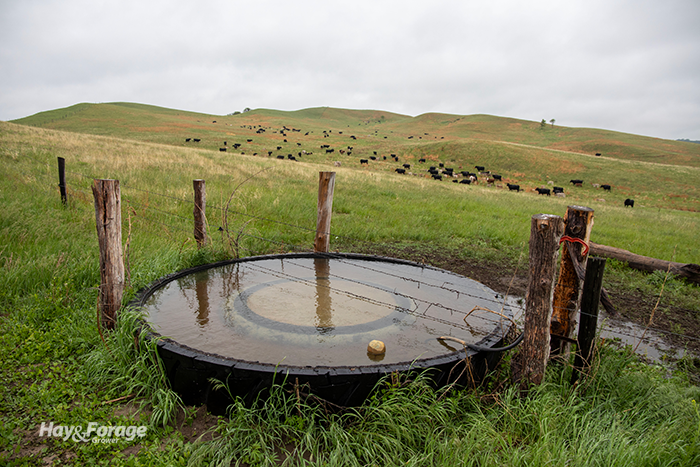
Even though water is the most important nutrient for livestock, it is often the most limiting. Forage intake will suffer if water intake doesn’t suffice, and animal health and performance hinge on water quality and availability.
In a recent article from Ohio State University Extension, Dan Kreager notes that beef cattle water requirements can range from 5 to 20 gallons per day, whereas dairy cattle can require up to 30. The agriculture and natural resources educator adds that monitoring water quality and dissolved solids concentrations is critical, and the placement of water sources throughout a pasture can affect livestock production, too.
High supply and optimum quality become obsolete if cattle don’t have open access to water. This can be challenging to facilitate in a rotational grazing system where one water source services several paddocks. Utilizing surface water like ponds, streams, and springs present other environmental obstacles as well.
“We are often reminded of the benefits of rotational grazing and frequent movement of animals. Improved pasture productivity, increased stocking density, better distributions of nutrient back onto pastures, and a reduction of weed issues all sound great, but what about a water source?” Kreager asks.
The amount of water that needs to be available at any given time in a paddock depends on the distance cattle must travel to drink it. For example, cows tend to approach water individually or in small groups if they are within 600 to 900 feet of a pond, tank, or trough. In this case, ensure there is enough space around the water source to accommodate roughly 3% of the herd at once.
On the other hand, if animals have to travel more than 900 feet to get to water, they will likely do so as a large group and then congregate in the area. This warrants a water source with room for 5% to 10% of the herd around the outside, and one that has a faster refill rate than the former scenario.
Sample dissolved solids
Surface water can be subject to more contamination from mud, algae, fertilizer runoff, manure, and urine than groundwater sources like tanks and troughs. Kreager suggests limiting access to ponds, streams, and springs with stones or fences to keep cattle from loitering in the area and help maintain cleaner water.
Testing the dissolved solids in surface water and groundwater will determine which sources are safe for livestock to drink from. Do not allow animals access to any source if lab results are greater than 5,000 parts per million (ppm). Water that is high in sulfur, manganese, iron, and nitrates can also be dangerous for livestock.
“Contamination of water sources with fertilizer or manure can lead to high nitrate levels in the water,” Kreager notes. “We often think about nitrate poisoning (in livestock) coming from forage, but the water source is another possibility, especially with a pond that receives field runoff.”
Water temperature also depends on water placement in a pasture. Kreager says animals will avoid water in tanks located in full sun that gets too hot, which negatively affects their daily intake. Smaller tanks with underground piping that can be replenished with fresh, cool water more efficiently are a better option.
Projects that aim to improve water sources may be eligible for funding from the Environmental Quality Incentives Program (EQIP). Kreager encourages producers who are interested in installing fences or other infrastructure to contact a local Natural Resources Conservation Service (NRCS) agent for more information about cost-share programs.

